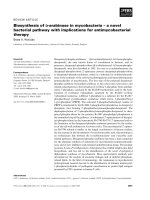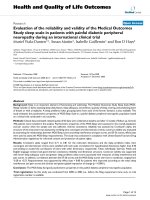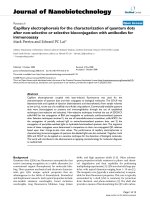Effectiveness of continuous epidural analgesia by bupivacaine 0 1% combined with fentanyl for pain attenuation during labor at hue central hospital
Bạn đang xem bản rút gọn của tài liệu. Xem và tải ngay bản đầy đủ của tài liệu tại đây (547.83 KB, 7 trang )
Hue Central Hospital
Original Research
DOI: 10.38103/jcmhch.83.13
EFFECTIVENESS OF CONTINUOUS EPIDURAL ANALGESIA BY
BUPIVACAINE 0.1% COMBINED WITH FENTANYL FOR PAIN
ATTENUATION DURING LABOR AT HUE CENTRAL HOSPITAL
Nguyen Thanh Xuan1, Le Van Dung1, Nguyen Trung Hau1, Nguyen Viet Quang Hien1,
Nguyen Thanh Quang1, Nguyen Ich Hai Nam1, Nguyen Thi Thanh Loan1, Pham Thi Diem
Hang1, Le Viet Nguyen Khoi1, Bui Anh Tuan1, Vo Hoang Phu1, Ho Le Nhat Minh1, Tran Trung
Hieu1, Nguyen Thai Hieu1, Cao Thi My Lai1
1
Department of Anesthesia and Resuscitation A, Hue Central Hospital
Received:
01/7/2022
Accepted:
09/9/2022
Corresponding author:
Le Van Dung
Email:
Phone: 0914194242
ABSTRACT
Introduction: Epidural analgesia was an extremely effective and popular treatment for
labor pain. This study aimed to assess the effectiveness and safety of combinational use of
bupivacaine 0.1% and fentanyl in epidural anesthesia for pain relief during labor.
Methods: A cross-sectional descriptive study was conducted on 270 parturients who
required epidural anesthesia for pain relief during labor. All parturients received 06ml
epidural solution of bupivacaine 0.1% with fentanyl (30μg). After 10 minutes, continuous
epidural infusion (CEI) at 6 ml/h with bupivacaine 0.1% + fentanyl (2µg/ml). Extra boluses
of 6ml solution of (bupivacaine + 0.1% fentanyl (2µg/ml) when VAS (Visual Analog Scale)
score >6 points. Measured variables included total bolus requests, pain Visual Analog
Scale (VAS), modified Bromage scores, labor duration, delivery outcome, and maternal
satisfaction after delivery.
Results: The average analgesia induction was 4.32 ± 0.58 minutes. VAS score ≤ 3
points: 88.52% of parturients, VAS score = 3-6 points: 8.52% of parturients (1 rescued
bolus) and VAS score> 6 points 2.96% of parturients (2 rescued bolus). There were
(208/270) 77.04% with normal labor. The average labor pain relief time was 161.98 ± 46.58
minutes. Side effects were as follows: Feeling numb in the leg (but still able to move): 8.15%;
transient chills: 3.33%; nausea: 2.96%, itching: 1.85%. There were no cases of headache,
hypotension, arrhythmia, respiratory failure and dural puncture. The average Apgar score
at the 1st minute was 8.35 ± 0.24 and at the 5th minute was 8.79 ± 0.07, without cases
of asphyxia. Regarding maternal satisfaction, very satisfied and satisfied levelsoccupied
74.04% and 25.96%, respectively.
Conclusion: In our study, continuous epidural analgesia by combinational use of
bupivacaine 0.1% and fentanyl(2µg/ml) provided effective labor pain relief, hemodynamic
stability, and normal neonatal outcomes.
Keywords: Labor pain relief,epidural anesthesia, continuous epidural infusion -CEI.
I. INTRODUCTION
Labor was a physiological process that occurred
naturally. A woman‘s vocation was to give birth.
However, research revealed that two-thirds
of pregnant women‘s pain during childbirth
was extremely painful, involuntary agony that
the mother must bear. Labor pain was now
Journal of Clinical Medicine - No. 83/2022
acknowledged to influence the mother‘s body,
anxiety, tiredness, and the fetus. Pain can also
make labor more difficult and complicated,
especially if the mother is psychologically ill and
has a low tolerance for pain. When the pain is
under control, women may find it easier to give
85
Effectiveness of continuous epidural analgesia
Bệnh việnby
Trung
bupivacaine...
ương Huế
birth naturally [1]. Therefore, pain relief during
labor was critical. There are currently several
methods for relieving labor pain; each method
has advantages and disadvantages;among them,
the continuous epidural infusion was the most
effective form of pain relief in labor [2]. Because
of the benefits of delivering continuous analgesia
and the mother to be awake, alertand comfortable
in labor and childbirth (mobility and pushing
during labor), continuous infusion of local
anesthetic into the epidural space for labor pain
relief has become popular [3]. The postpartum
period was less stressful, and the mother
healed rapidly, resulting in a shorter hospital
stay. Thus, labor pain relief with continuous
epidural anesthetic was critical for addressing
three medical, economic, and psychological
issues. We conducted this study to determine the
level of labor pain alleviation by infusion of a
bupivacaine 0.1% and fentanyl (2 g/ml) mixture
in the epidural space, and determine the side effects of the procedure.
II. MATERIALS AND METHODS
2.1. Subjects
Inclusion criteria: Pregnant women aged 18-40,
full-term fetuses with normal development; there
were indications for epidural anesthesia, with a
written consent form for epidural analgesia for labor
pain relief; obstetrically, there were indications for
natural birth.
Exclusion criteria: abnormal fetal position:
transverse, breech or facial; oligohydramnios
or polyhydramnios; placenta previa, placental
abruption; fetal heart failure, preterm or overdue
fetus; abnormal uterine contractions or abnormal
progress of labor. Pregnant women were suffering
from mental illnesses and lack of collaboration. Have
had a pre - history of cesarean section or uterine
fibroids excision.
The research was conducted at the Department
of Anesthesia and Resuscitation A, Hue Central
Hospital, from June 2021 to April 17, 2022.
2.2. Methods
A cross-sectional descriptive study was conducted
on 270parturients who required epidural anesthesia
for pain relief during labor
86
Equipment serving for study:
- Monitoring: Keep track of your pulse, blood
pressure, and SpO2
- Monitoring fetal heart rate and uterine
contractions (Figure 1)
- Electric syringe, 50ml, 10ml, 5ml, 1ml syringe.
- Continuous epidural anesthesia kit (Figure 2)
- Local anesthetic: Bupivacaine 0.5% 100 mg
in 20ml
Figure 1: Fetal Heart Monitoring
Figure 2: Epidural continuous infusion kit
Epidural anesthesia procedure:
- Preparing the pregnant woman before the
epidural anesthesia procedure: The obstetrician and
anesthesiologist examined the pregnant woman to
determine if she was eligible for labor analgesia
and explained to her the benefits and adverse effects
of this method understand and cooperate. Insert an
intravenous line.
- Implementing the continuous epidural infusion
technique: Anesthesia moment: 3 cm dilated cervix.
Performing epidural anesthesia [4].
Journal of Clinical Medicine - No. 83/2022
Hue Central Hospital
Figure 3: Lying on the side with the back arched. Needle insertion site: L3-4; if difficult, look for L2-3.
The “loss of resistance” technique, air/saline test to identify the epidural space, is used to determine the
epidural space. Insert the catheter 3 - 5 cm toward the mother’s head into the epidural space.
Table 1: How to mix and adjust anestheticsfor labor pain relief [4]
Volume of anesthetic required
Mixing anesthetic and solution concentration
Test dose: Required, 02 ml
2.1ml: 2ml Lidocaine 2%; 10µg Adrenaline
(adrenaline 1mg mix 10ml) 0.1ml= 10µg
Bolus dose: 5 minutes after test dose. 06 ml
(bupivacain 0,1% + fentanyl 30µg)
10 ml: 2ml Bupivacain 0,5%; 1ml Fentanyl (50µg);
7ml NaCl 0,9% (bupivacain 0,1% and fentanyl 5µg/
ml)
Maintenance dose: 10 minutes after bolus dose
Infusion through an epidural catheter 06ml/h
Bupivacain 0,1% + fentanyl (2µg/ml)
50 ml: 10ml Bupivacain 0,5%; 2ml Fentanyl
(100µg); 38ml NaCl 0,9% Solution (*): (bupivacain
0,1% + fentanyl 2µg/ml)
Rescue dose: Bolus 06 ml Solution (*) when
VAS score > 6 points
Dose of abortion and perineal suture: 08ml
solution (*)
Data collection and follow-up after epidural anesthesia.
- Indicating the assessment time: Before anesthesia starts. Every 5 minutes after anesthesia inductionfor
30 minutes. During labor: Stage II. When the cervix was completely open. During the episiotomy procedure.
- Monitoring: Heart rate, blood pressure and SpO2.
- Monitoring analgesia quality: Determine the time of anesthesia induction (minutes). Analgesic
effectiveness evaluation: VAS scale:
+ No leg numbness when VAS ≥ 5 or face ≥ 2 was used. 2ml/h increase in maintenance dose.
+ No leg numbness when VAS ≥ 7 or face ≥ 4 was used. 5ml rescue dose bolus; repeated after 5 minutes
of assessment. When the VAS is ≤ 2 or the face was ≤ 1; reducing the daily maintenance dose to 2ml/h.
If both legs were numb, temporarily stopped the maintenance dose until the numbness in both legs went
away. If the woman was still in pain, or because of an incorrectly placed epidural catheter, or inconvenient
obstetric evolutions.
Journal of Clinical Medicine - No. 83/2022
87
Effectiveness of continuous epidural analgesia
Bệnh việnby
Trung
bupivacaine...
ương Huế
Figure 4: VAS ruler measuring pain intensity
- According to Bromage scale, monitor motor blockage:
M0: no paralysis (0%); M1: Straightening the legs without lifting them off the tabletop (25% inhibition);
M2: The knee unable to bend, but the foot can move (50%); M3: Completely failed to flex foot and thumb
(100%)
There is a loss of movement if the lower extremities are numb. M ≥ 1. Reduce the maintenance infusion
dose or temporarily suspend the maintenance of local anesthetic until the woman can move again.
M=3 if all movements are lost. Stop local anesthetic injection and consider inserting a catheter into the
subarachnoid space.
- Labor monitoring: Check the fetal heart rate and uterine contractions. Infusion of oxytocin: As directed
by the obstetrician. When labor is “adverse,” an emergency cesarean section is performed.
- Determine the infant’s condition using the Apgar score at 1 and 5 minutes [5]: 3 points for severe
asphyxia and active resuscitation. Asphyxia of 4-6 points: Mild to moderate. 7 points: Excellent condition,
no asphyxia.
- Examination of unfavorable effects: Pruritus is classified into three levels: pruritus, rash, and papules.
Nausea and vomiting, dural puncture causes headaches. An arrhythmia occurs when systolic blood pressure
falls by more than 20% from baseline.
- Assessing pregnant women’s satisfaction through interviews: Very satisfied, satisfied, and dissatisfied
2.3. Data analysis
SPSS 20.0 software was used for data processing. Using the student’s t-test to compare two means
(quantitative with normal distribution). Using Mann-Whitney, compare two means (quantitative, not
normally distributed).Use the χ2 test to compare the proportions of qualitative variables. The difference is
statistically significant at p=0.05.
III. RESULTS
3.1. Research subject characteristics
Table 1: Maternal age, height, and weight
N=270
Min - Max
X ± SD
Age (year)
21 – 38
26,94 ± 4,28
Height (cm)
149 – 170
156,26 ± 4,71
Weight (kg)
48 – 78
59,36 ± 6,86
The average age was 26.94 years old, which fell within the reproductive age range. The dose of local
anesthetic was related to a mean height of 156.26cm and a mean weight of 59.36kg.
88
Journal of Clinical Medicine - No. 83/2022
Hue Central Hospital
Table 2: The study’s proportions of first, second, and third children
Number of births
Amount
%
First child
194
71,85
Second child
64
23,70
Third child
12
4,45
p
< 0,01
The rate of the first-born childin the study was 71.85%, while the rate of the second child was 28.15%;there
was a statisticallysignificant difference. The high first–born child rate was related to a longer mean labor time.
Table 3: Birth weight and gestational age
Min - Max
X ± SD
38 – 41
38,64 ± 0,71
2700 – 3800
3124,02 ± 325,86
Gestational age (weeks)
Birth weight (grs)
Normal labor was associated with a mean gestational age of 38.64 weeks and a mean gestational weight
of 3124.02g. The greater the weight, the more difficult it was to give birth.
3.2. Result of labor pain relief
Chart 1: Epidural anesthesia location
The needle insertion site at L3-4 for epidural analgesia accounted for 91% of all cases and was the best
site for labor epidural analgesia.
Table 4: The distance between the skin and the epidural space, as well as the length of the catheter
insertion into the epidural space
Distance (cm)
Min - Max
X ± SD
From the skin to the epidural space
3,2 – 4,8
4,17 ± 0,32
Catheter length inserted into the epidural space
3,0 – 5,0
4,37 ± 0,53
The average distance between the skin and the epidural space was 4.17±0.32cm. The catheter’s average
length inserted into the epidural space was 4.37±0.53cm, making it suitable for the needle puncture site at
the L3-4.
Journal of Clinical Medicine - No. 83/2022
89
Effectiveness of continuous epidural analgesia
Bệnh việnby
Trung
bupivacaine...
ương Huế
Table 5: Cervical dilation during epidural anesthesia
Tổng
First child
The following child
Min – Max
X ± SD
Min – Max
X ± SD
P
Cervical dilation during epidural
3–5
3- 6
< 0,05
anesthesia (cm)
3,25 ± 0,42
4,88 ± 0,86
The mean cervical dilation of women giving birth to their first child wassignificantly less than that of
their following child, p < 0.05.
Table 6: Mean time of anesthesia induction in the study
Min – Max
X ± SD
Time of anesthesia induction (minutes)
4–7
4,32 ± 0,58
The average anesthesia induction time was 4.32 ± 0.58 minutes, with the longest time till 7 minutes.
Table 7: Change in VAS score in labor
Min – Max
X ± SD
Before epidural anesthesia
5–9
7,12 ± 1,08
After 5 minutes
2–7
3,34 ± 0,98
After 10 minutes
1–5
2,18 ± 0,72
After 15 minutes
0–4
1,82 ± 0,75
After 20 minutes
1–5
1,34 ± 0,75
After 25 minutes
0–4
1,14 ± 0,73
After 30 minutes
0–5
1,20 ± 0,76
When the cervix completely open
1–6
3,42 ± 1,16
Phase II
1–5
3,26 ± 0,90
Performing procedure
1–5
3,07 ± 1,22
P
< 0,01
Uterin check and uture perineal
1–4
2,04 ± 0,84
The difference was statistically significant when comparing the average VAS score before and after
epidural anesthesia (p<0.01). At all stages of labor, the mean VAS score after epidural anesthesia was <4
(no pain or little pain).
Table 8: VAS-based efficacy rate of continuous epidural analgesia
N = 270
Amounts
Percentage
VAS ≤ 3 incontractions
239
88,52
3 < VAS ≤ 6
23
8,52
VAS score> 6 points dose adjusted
08
2,96
The rate of epidural anesthesia with good pain relief VAS≤3 points is 88.52%. Women with at least 01
VAS>3-6 required 1 rescue bolus, while VAS>6 required 2 rescue bolus. There were two cases (0.74%) in
which an epidural catheter could not be placed (not included in the study).
90
Journal of Clinical Medicine - No. 83/2022
Hue Central Hospital
Table 9: Time of labor with epidural analgesia
Tổng
Labor time (minutes)
First child
The following child
Min – Max
X ± SD
Min – Max
X ± SD
60 – 540
185,26 ± 89,37
30 - 350
136,94 ± 56,52
P
< 0,05
The average labor time for the first child was longer than for the second child with p<0.05
Chart 2: Pain relief percentage in vaginal and cesarean deliveries
The normal birth rate is 208/270, which accounts for 77.04% of all births. Because of the study’s high
birth rate.
Table 10: According to Bromage in the study, the degree of motor paralysis
N = 270
N
%
M0: no paralysis
248
91,85
M1: Inability to raise the extended leg
22
8,15
M2: Inability to flex the knees, able to move the feet only
0
0
M3: Inability to flex the ankle and digits
0
0
The pregnant women were completely normal, with no lower extremity weakness accounting for 91.85%
and a sensation of heaviness and numbness in the legs accounting for 8.15%.
Table 11:The ability of the mother to push to give birth
N= 208
Amounts
%
Very good
163
78,37
Good
41
19,71
Weak
04
1,92
The ability to push birth is very good at 78.37% due to no or little inhibition of movement.
Journal of Clinical Medicine - No. 83/2022
91









